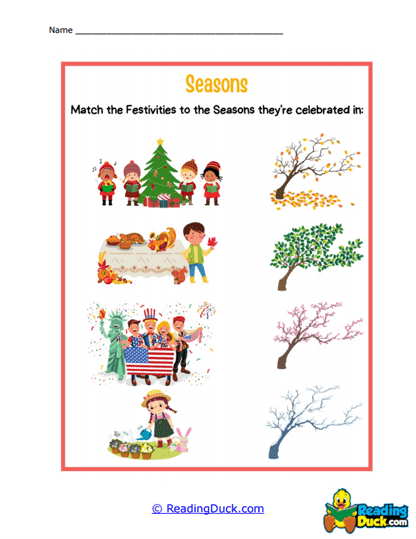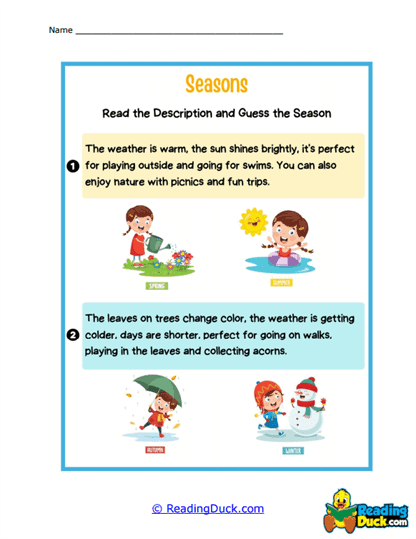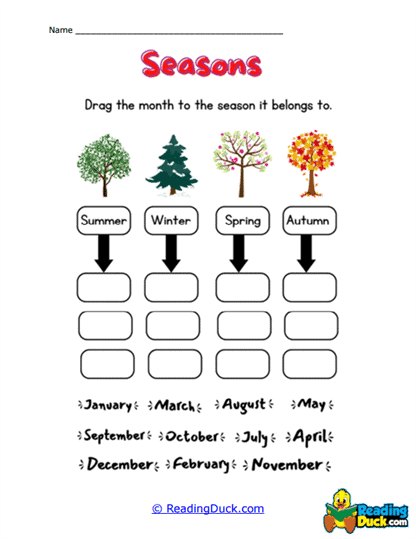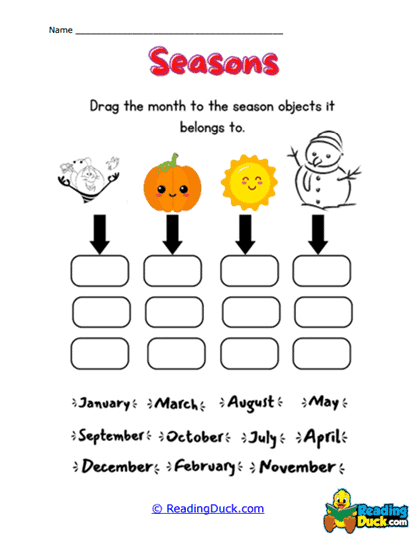Seasons Worksheets
About Our Seasons Worksheets
Our Seasons Worksheets collection provides an engaging and comprehensive resource for students to explore and master vocabulary related to the four seasons: spring, summer, fall (autumn), and winter. Falling under the Vocabulary category in the Skills section, these worksheets are specifically designed to help students build a strong foundation in understanding and using season-related terms. Each worksheet in this collection is available in PDF format, making it simple for teachers, parents, and students to view, download, and print. For ease of use, each worksheet comes with a downloadable answer key, ensuring quick reference and guidance.
This collection of worksheets is not just about learning seasonal vocabulary; it’s about understanding the deeper context in which these words are used. Students will gain knowledge about the characteristics, weather patterns, and cultural events associated with each season, which will aid in expanding their language comprehension. Whether used in a classroom or during independent study, our Seasons Worksheets support students in developing their vocabulary while also connecting them to the natural cycles of the year.
The Role of Seasonal Vocabulary in Language Development
Seasonal vocabulary is an integral part of early language development. Understanding the words associated with the seasons allows students to describe the world around them more accurately and to engage in conversations about time, nature, and daily life. Words like "bloom," "harvest," "snowfall," and "heatwave" enrich students' descriptive language, enabling them to articulate the changes in their environment throughout the year.
Learning seasonal vocabulary enhances a student's ability to communicate effectively in several ways:
- Descriptive Skills: Seasonal vocabulary introduces descriptive terms that are used in everyday conversations, stories, and academic contexts. For example, students learn to describe how plants grow in the spring or how temperatures drop in the winter, enhancing their narrative abilities.
- Cultural Understanding: Many seasonal terms are tied to cultural events and holidays, such as "harvest festival," "winter solstice," or "summer vacation." Understanding these terms helps students better comprehend stories, traditions, and historical events.
- Science Connections: Seasons are not just vocabulary topics; they also intersect with science. As students learn seasonal vocabulary, they also become more familiar with concepts like weather patterns, changes in daylight, and the life cycles of plants and animals.
By mastering seasonal vocabulary, students can enrich their communication skills, improving both their spoken and written language. This foundational vocabulary topic also sets the stage for more advanced language learning, as it connects students with a wide range of interdisciplinary topics.
Enhancing Vocabulary and Language Comprehension
Our Seasons Worksheets are designed to help students expand their vocabulary and improve their language comprehension by introducing them to a wide array of words associated with the four seasons. From learning the names of specific weather conditions like "drizzle" and "blizzard" to exploring activities tied to each season, these worksheets immerse students in language that is both practical and relevant.
The benefits of mastering seasonal vocabulary include:
- Improved Reading Comprehension: Understanding seasonal vocabulary allows students to grasp the context of stories, poems, and informational texts that describe seasonal changes. For example, in reading a story about autumn, students will be able to identify and understand words like "falling leaves," "chilly winds," or "pumpkin patch."
- Contextual Understanding: Learning words in the context of seasons helps students relate new vocabulary to real-world experiences. As they recognize changes in their own environment, such as flowers blooming in spring or the heat rising in summer, they can better understand and apply seasonal vocabulary.
- Critical Thinking and Creativity: By building their seasonal vocabulary, students are also encouraged to think critically about the environment. They can use this vocabulary to describe seasonal patterns, predict weather changes, or write creatively about what happens during different times of the year.
Our worksheets go beyond memorizing vocabulary. They encourage students to explore the world around them through language, promoting an immersive learning experience that enhances both vocabulary acquisition and comprehension skills.
Flexibility and Accessibility in Different Learning Environments
One of the major strengths of our Seasons Worksheets is their flexibility and accessibility, making them suitable for a wide variety of learning environments. Whether they are used in a traditional classroom, for homeschooling, or during independent study, these worksheets provide structured yet adaptable learning materials for students of all ages.
Here are some examples of how these worksheets can be used effectively:
- Classroom Instruction: Teachers can incorporate these worksheets into their daily lessons, using them to introduce or reinforce seasonal vocabulary. They can also serve as supplementary materials for lessons on weather, time, or environmental science.
- Homework Assignments: The PDF format of these worksheets makes them perfect for homework assignments. Students can practice seasonal vocabulary at home, completing the worksheets independently, while parents and teachers can check their progress using the downloadable answer key.
- Independent Study: For self-motivated learners, these worksheets provide a clear path to learning new vocabulary on their own. The structured format allows students to progress at their own pace, building their understanding of seasons and related vocabulary concepts.
This adaptability ensures that students can use the worksheets in multiple settings and formats, making them a practical resource for teachers, parents, and students alike.
Suitable for Group and Individual Learning
Our Seasons Worksheets are designed for both group and individual learning, making them an ideal tool for educators seeking to foster collaboration as well as independent skill-building. Whether students are working alone, with peers, or in larger classroom groups, these worksheets can accommodate a variety of learning approaches.
- Individual Learning: For individual learners, the worksheets provide a structured, guided approach to mastering seasonal vocabulary. Students can work at their own pace, developing their language comprehension and building confidence in their vocabulary skills.
- Group Activities: Teachers can also incorporate these worksheets into group activities, where students work together to explore seasonal vocabulary. This not only promotes teamwork and peer learning but also allows students to engage in discussions and collaborative problem-solving as they work through the material.
The combination of individual and group learning opportunities means that these worksheets can be used in a variety of educational contexts, making vocabulary learning both engaging and dynamic for all types of learners.
Adaptable Across Grade Levels and Abilities
Our Seasons Worksheets are suitable for a wide range of grade levels, from early elementary school through middle school. The adaptable nature of these worksheets ensures that they can be tailored to meet the specific learning needs of different age groups and abilities.
- Elementary School: For younger learners, the worksheets focus on simple, everyday vocabulary related to the seasons. Students will learn basic terms such as "snow," "rain," "sunshine," and "leaves," helping them describe the world around them as they experience the changes of each season.
- Middle School: As students progress through middle school, the worksheets introduce more complex vocabulary, encouraging learners to engage with advanced seasonal terms like "equinox," "solstice," and "temperate." This helps them develop a richer understanding of the natural world and its cycles.
The worksheets can also be adapted for classrooms with mixed abilities, allowing teachers to differentiate instruction and provide appropriate challenges for all students. Whether used in a single-grade classroom or a multi-grade homeschooling environment, these worksheets offer valuable learning opportunities for students at different stages of language development.
Supporting Long-Term Vocabulary Development
Our Seasons Worksheets are designed to be integrated into long-term vocabulary development programs, helping students build a lasting foundation in seasonal vocabulary. By reinforcing key concepts over time, teachers can ensure that students retain their understanding of seasonal words and continue to build upon this knowledge as they advance through their studies.
For example:
- Early Grades: In the early grades, students are introduced to the basic vocabulary associated with each season. As they learn about the changes in weather and nature throughout the year, they become familiar with common seasonal terms that will support their overall language development.
- Later Grades: As students move into middle school, they can expand their vocabulary with more advanced seasonal terms. Teachers can use the worksheets to deepen students’ understanding of the natural world, linking vocabulary learning to broader academic concepts like weather patterns, climate change, and environmental science.
This long-term approach to vocabulary development helps ensure that students not only learn seasonal terms but also understand how these words fit into the broader context of their language learning and academic studies.
Conclusion
Our Seasons Worksheets provide an invaluable resource for mastering seasonal vocabulary, offering students the tools they need to build their language comprehension and communication skills. Available in an accessible PDF format with downloadable answer keys, these worksheets are suitable for classroom use, homework, or independent study. With their adaptability across grade levels and learning environments, these worksheets support individual and group activities, helping students develop a deep understanding of seasonal vocabulary that enhances both their academic and real-world communication skills. Whether used as part of a short-term lesson or integrated into a long-term vocabulary development program, these worksheets help students grow their vocabulary in meaningful and lasting ways.









